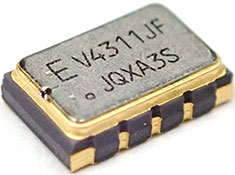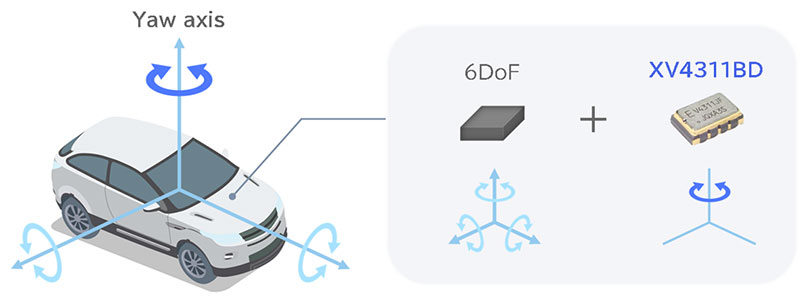Epson Now Shipping AEC-Q100-Compliant Automotive Yaw Rate Sensor
- The XV4311BD enables both high precision and low cost for vehicle localization -
- TOKYO, Japan, July 22, 2025 -
Seiko Epson Corporation (TSE: 6724, "Epson") has developed and is now shipping in volume the XV4311BD, a high-precision yaw rate1 sensor (single-axis gyro sensor) compliant with AEC-Q100 standards. This new sensor is designed for automotive inertial sensor applications such as autonomous driving (AD) and advanced driver-assistance systems (ADAS). Manufacturers can integrate the XV4311BD into automotive systems to achieve precise and cost-effective vehicle localization and help advance next-generation mobility solutions.

Practical applications and implementations of autonomous driving technologies have been advancing rapidly in recent years, driven by efforts to reduce traffic accidents, alleviate congestion, and support mobility for the elderly and other populations. To ensure the safe and reliable operation of autonomous vehicles, it is essential to estimate vehicle position with high precision regardless of the external environment. This makes the performance of onboard gyro sensors critically important. At the same time, total vehicle cost must be reduced for these technologies to become widely adopted, necessitating a careful balance between performance and cost in components such as gyro sensors.
The XV4311BD can be used in combination with a six-axis inertial sensor (6DoF)2, which measures a vehicle's angular velocity3 and acceleration, to provide even greater yaw-axis angular velocity-considered particularly critical for position estimation. Using a high-precision sensor specifically for the yaw axis enables the system to achieve the required accuracy for vehicle localization while keeping costs low. Furthermore, the yaw-axis angular velocity data from the XV4311BD and that from the 6DoF sensor can be compared to enable fault detection and redundant system configurations4, thereby enhancing system safety.
This product provides excellent bias stability5 thanks to Epson's proprietary quartz crystal gyro sensor element6 and integrated circuit (IC)7. To meet the requirements of automotive applications, it is equipped with diagnostic functions and complies with AEC-Q100, the reliability standard for automotive electronic components.

As human society becomes increasingly advanced and complex, sensing devices such as gyro sensors are expected to deliver even higher levels of precision and reliability. Epson remains committed to developing and providing compact, low-power sensing devices that combine high precision, low noise, and exceptional stability. Through these innovations, Epson will continue to contribute to improved safety and usability across a wide range of fields, including consumer electronics, industrial applications, and automotive systems.
- 1 The rotational axis that runs vertically through the vehicle, representing rotation around the vertical direction
- 2 6DoF (Six Degrees of Freedom) sensors typically detect motion across three axes of angular velocity and three axes of linear acceleration.
- 3 Angular velocity refers to the rate of rotational motion, expressed as the angle of rotation per unit time.
- 4 A redundant system configuration uses multiple devices with the same function, allowing the overall system to continue operating normally even if one device fails.
- 5 Bias stability refers to the consistency of a sensor's output offset (zero point) over time and under varying environmental conditions.
- 6 A double-T type quartz gyro sensor element with separated drive and detection sections
- 7 An integrated circuit (IC) optimized for the sensor element, incorporating signal processing and various functional features
Product Features
- Bias Instability: 0.9°
- Angle Random Walk: 0.065°/√h
- Compliant with the AEC-Q100 automotive-grade reliability standard for electronic components
- Equipped with fault diagnosis functionality for enhanced system safety
Target Applications
- High-precision localization systems for autonomous driving (AD) and advanced driver-assistance systems (ADAS)
- Navigation systems for mobile platforms (GNSS, INS)
Product Overview
| Product name | XV4311BD |
|---|---|
| Automotive standard compliance | AEC-Q100 |
| Rate Range | ±115°/s / ±460°/s |
| Bias Instability (minimum allan variance8) | 0.9°/h |
| Angle Random Walk (ARW) | 0.065°/√h |
| Bias Tolerance | ±1°/s |
| Bias temperature coefficient | 0.0019 (°/s)/℃ |
| Non-linearity | ±0.05%FS |
| Operating Temperature | -40 to +105℃ |
| Current Consumption | 2.5mA (Max.) |
| Interface | SafeSPI |
| Product Dimensions | 5.0 × 3.2 × 1.3mm |
- * Specifications are typical values unless stated otherwise.
- 8 One of the indicators of gyro sensor output stability. It represents the extent of variation in output depending on the averaging time-the smaller the value, the higher the precision
Related Links
For more detailed product information, please refer to the following webpage.
https://www.epsondevice.com/crystal/en/products/sensor/
Customer Contact Information
MD Sales Department, Seiko Epson Corporation
https://www.epsondevice.com/crystal/en/contact/
About Epson
Epson is a global technology leader whose philosophy of efficient, compact and precise innovation enriches lives and helps create a better world. The company is focused on solving societal issues through innovations in home and office printing, commercial and industrial printing, manufacturing, visual and lifestyle. Epson's goal is to become carbon negative and eliminate use of exhaustible underground resources such as oil and metal by 2050.
Led by the Japan-based Seiko Epson Corporation, the worldwide Epson Group generates annual sales of more than JPY 1 trillion.
corporate.epson/en/


